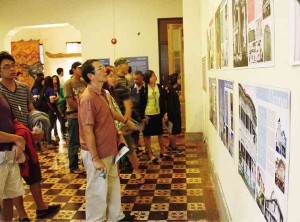
The beauty, functionality and diversity of Philippine architecture were in full play during several conferences and forums in connection with the Philippine Arts Festival and National Arts Month recently.
“There is no singular Filipino style of architecture. Architectural styles change and adapt through time as materials, building construction technology and theoretical and conceptual ideas evolve,” the “Istilo” exhibit notes said.
“Istilo” is one of the programs of Archi[types/text], the flagship project of the National Commission for Culture and the Arts’ (NCCA) National Committee on Architecture and Allied Arts (NCAAA). It was launched last Feb. 6 at the Far Eastern University and was installed in Bacolod’s Negros Museum last Feb. 19.
Aside from the exhibit, its book, “Istilo: Pocket guide to Architectural Styles in the Philippines,” was also released.
The earliest Filipino style mentioned in the exhibit is categorized as “Vernacular/Asian Traditions,” which includes the Maranao’s torogan (Vernacular), Ivatan’s rakuh (Vernacular), Cebu Taoist Temple (Chinese), and Sultan Hassanal Bolkiah Masjid in Cotabato (Islamic).
The influence of European architecture was introduced to the country during the Spanish occupation. The exhibit labeled the architectural style during this period as “Spanish Colonial/European Traditions.” The prominent structures built during this time are San Agustin Church (Baroque); Malacañang Palace (Italianate); San Sebastian Church (Gothic).
“American Colonial/Euro-American Traditions” in Philippine archicture were formed during the American colonization in the Philippines. Among the constructions built during this period were Cebu Provincial Capitol (Neoclassical); Philippine Normal University (California Mission style); National Museum of the Philippines (Palladianism); Metropolitan Theater (Art Deco); and the Jose Bautista house in Malolos Bulacan (Art Nouveau).
Postwar style of Philippine architecture is classified as “Post-Independence/Post-Colonial.” The buildings which are part of this group are Philam Life Building in Manila (Modernism); National Library (Bauhaus); Central Bank of the Philippines (Brutalism); Araneta Coliseum (Space Age); Cultural Center of the Philippines (Bagong Lipunan Modernism).
During the 1960s, the traditions of the Vernacular style were mixed with the formal principles of Modernist style such as Felipe Mendoza’s Holiday Hills Golf Club House and Francisco Fajardo’s Max’s Restaurant. This has initiated another category for Philippine architecture named “Contemporary/New Millenium.”
Some of the works included in this category are Philippine Stock Exchange (Globalism); College of St. Benilde’s School of Design and Arts (Deconstructivism); Ninoy Aquino International Airport 3 (High Tech); Zamboanga International Airport (Neovernacular); and San Miguel Headquarters Complex (Green Architecture).
Mosque exhibit at UST
The University of Santo Tomas (UST), granted by the Vatican the title of “The Catholic University of the Philippines,” meanwhile, hosted an exhibit on Muslim mosques. “Masjid/Mosque: Jewels of Philippine Islamic Faith” opened last Feb. 5 at the UST Museum.
“It is the first of its kind to be shown in a Catholic school; in a way, our approach was unconventional,” NCAAA head Gerard Lico said. “Our philosophy (for this) is ‘art is for all.’ It’s quite easy (for UST to agree on doing ‘Masjid’) because the curators, UST Museum director Fr. Isidro Abano and UST Museum assistant director Anna Bautista, are very progressive.”
Lico also noted that the Muslim community is very much interested on seeing the exhibit. He said he will be bringing the exhibit to Autonomous Region in Muslim Mindanao (ARMM).
Cultural tour and lectures
Among the programs of Archi[types/text], Lico mentioned ’Padyak Manila,’ a heritage tour in Manila using bicycles But despite many people expressing interest to join it, ’Padyak Manila’ could not accommodate everyone.
“It was a logistical nightmare for me,” said Lico. “I had to hire an ambulance and had coordination with the Metro Manila Development Authority. It was also the first time that we used the bicycle to tour the heritage sites of Manila so many are really interested but we can only accommodate 100. It was a good event but very hard to manage. The participants are very much appreciative.”
It was also the first time from the flagship project of NCAAA to launch a documentary about Philippine architecture. It was premiered in University of the Philippines Diliman and screened later in Iloilo.